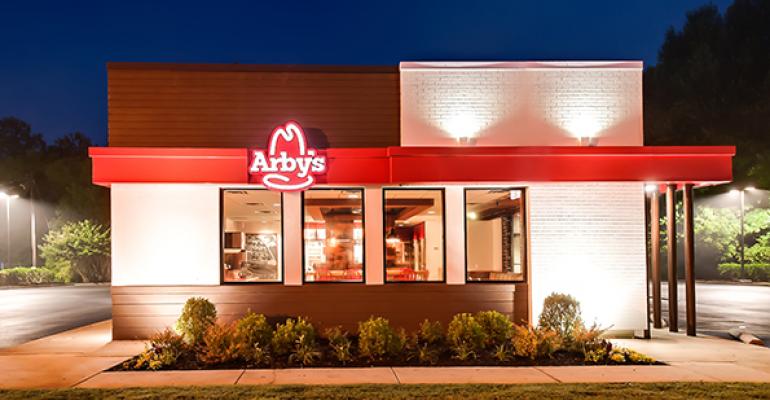More than four years of rising same-store sales has given Arby’s Restaurant Group Inc. the confidence to accelerate unit growth, something it hasn’t done since 2008.
The Atlanta-based quick-service operator is on pace to add 60 units this year, and plans to double that rate of growth next year, as it looks to increase systemwide sales 23 percent by 2018, to more than $4 billion. Systemwide sales were $3.3 billion in 2014
“Last year we turned our attention to unit growth,” Arby’s CEO Paul Brown said. “We’ve been improving unit economics. And we feel very confident about that $4 billion.”
Those new units could include areas such as urban locations and strip mall end caps that Arby’s has avoided.
The company recently introduced an “Inspire” design, with smaller standalone units, along with urban and end-cap locations. Brown said the restaurants have performed above expectations so far.
“We’re working on formats to allow Arby’s to go into places we haven’t historically gone into in a big way,” he said.
Unit growth is a long time coming for Arby’s, which hadn’t expanded much in a decade. Systemwide sales fell 15 percent from 2008 through 2010, and the number of units in the system fell 10 percent between 2008 and last year, according to Nation’s Restaurant News data.
But same-store sales began increasing in the third quarter of 2010, shortly before Roark Capital Group bought the chain from Wendy’s. Sales have been improving ever since, for 18 consecutive quarters. And Arby’s has increased unit volumes by more than $200,000 per location during that time, Brown said.
In the first quarter of this year, ended April 4, same-store sales increased 9.8 percent. Among quick-service chains whose sales results are publicly available, only Sonic Corp., whose same-store sales rose 11.5 percent during its second quarter ended Feb. 28, performed better.
The company’s economics have improved so much that Arby’s has largely resisted an industrywide push to refranchise. The company owns 940 of its 3,300 locations, and although Brown suggested that refranchising is a possibility in the future, it’s not in the plans now.
“We are benefitting so much from the improved unit economics,” Brown said. “We’re comfortable with that ratio.”
Brown said the company has improved sales by establishing itself between quick-service restaurants and fast-casual concepts — what it calls “fast crafted.”
“We win versus QSR by having high-quality food, equally convenient and for a good price,” Brown said. “We win versus fast-casual with equal quality food at a more value-oriented price, and more convenient because we have more locations and better speed of service.”
Arby’s has introduced innovative menu items and touted them in a popular marketing campaign featuring the distinctive bass voice of actor Ving Rhames.
The company’s outperformance against other quick-service chains began in the fourth quarter of 2013, after it introduced a popular Smokehouse Brisket sandwich.
By using limited-time offers, Brown said, Arby’s got the appearance of having variety, even as it actually cut items from the menu.
“It creates this real sense of variety, but we haven’t had to add to the core menu on an ongoing basis,” he said, noting that the brisket sandwich was the only new product addition in recent years.
Indeed, Brown said the company is careful to ensure that its operations are simple. For instance, Arby’s recent Rachel sandwich limited-time offer was done alongside its Reuben sandwich. The Rachel is similarly constructed, with just two different items — turkey instead of corned beef, and coleslaw instead of sauerkraut. Only the coleslaw was new.
“It added an entirely new dimension from a guest standpoint and a whole new product to the line, and it created new buzz,” Brown said. “But we minimized complexity.”
Service is another key element. Last year, the company held a service initiative called “Brand Champ” in which workers at each of its restaurants were taken offsite for half a day, where the company spoke with them about the brand, its vision and its service culture. The end of the day included a goal-setting exercise, and even part-time employees were included in the effort.
All told, 57,000 workers participated, and Arby’s will hold the event again this year.
“You can see the results,” Brown said. “It’s a critical focus. The team members deliver brand experience for consumers. We can have the best plan from culinary, but if the team members are not building them the right way and the service experience is not there, it’s all for naught.”
Brown said Arby’s product pipeline and service efforts will continue the sales momentum. So, too, will its remodeling efforts. The company completed 34 remodels last year, and is on track to remodel 180 locations this year. Remodels so far have generated a 15-percent sales lift per unit.
“At the end of the day, you get sales growing, and the flow-through on that overcomes all the other challenges that might happen,” Brown said. “It has a nice impact on the franchisee and the company.”
Contact Jonathan Maze at [email protected].
Follow him on Twitter: @jonathanmaze





